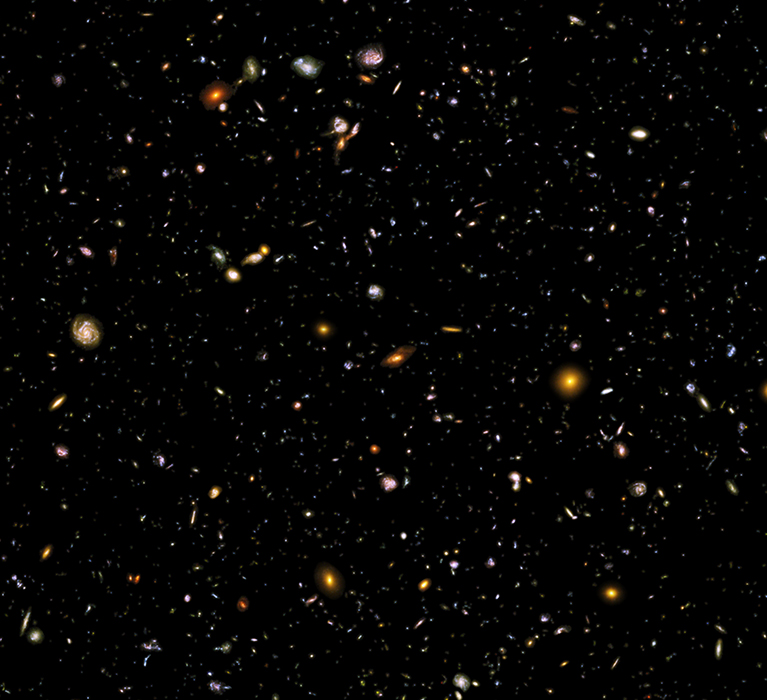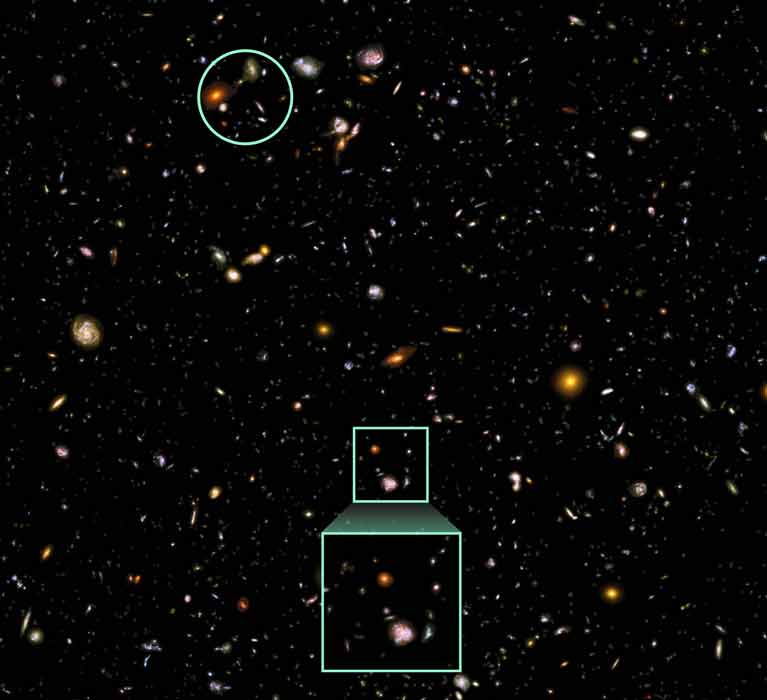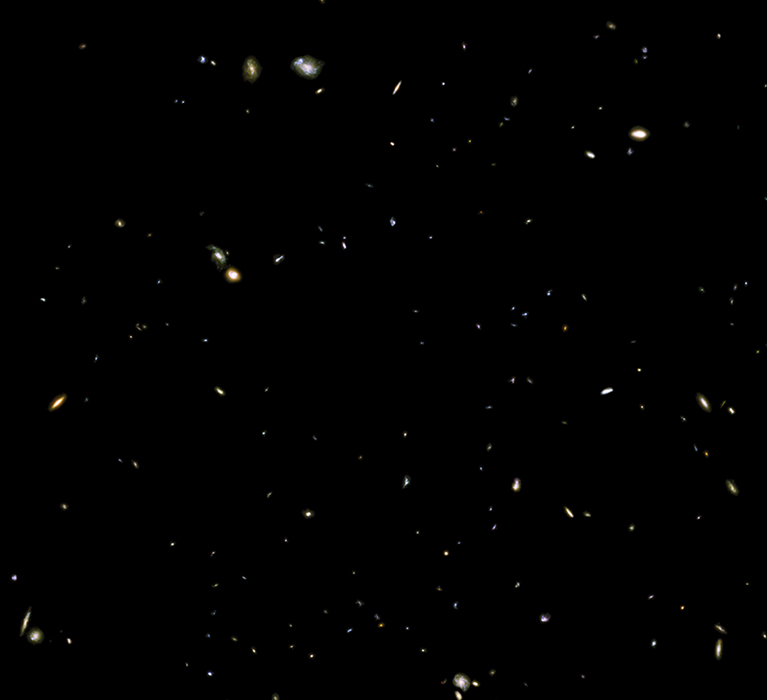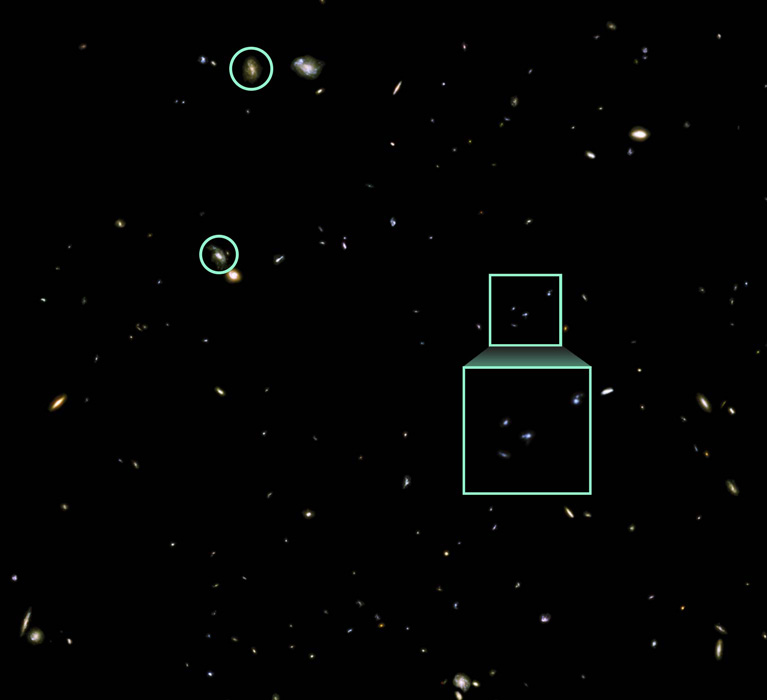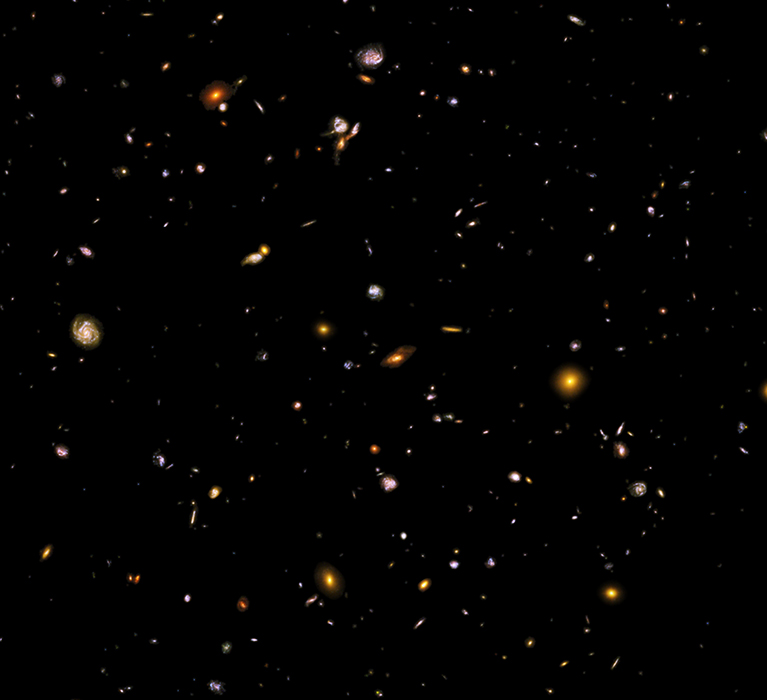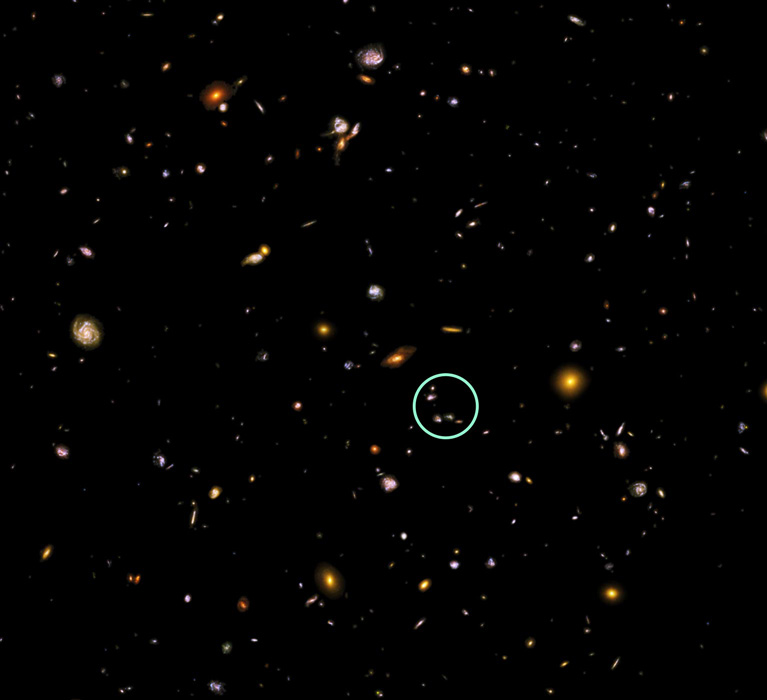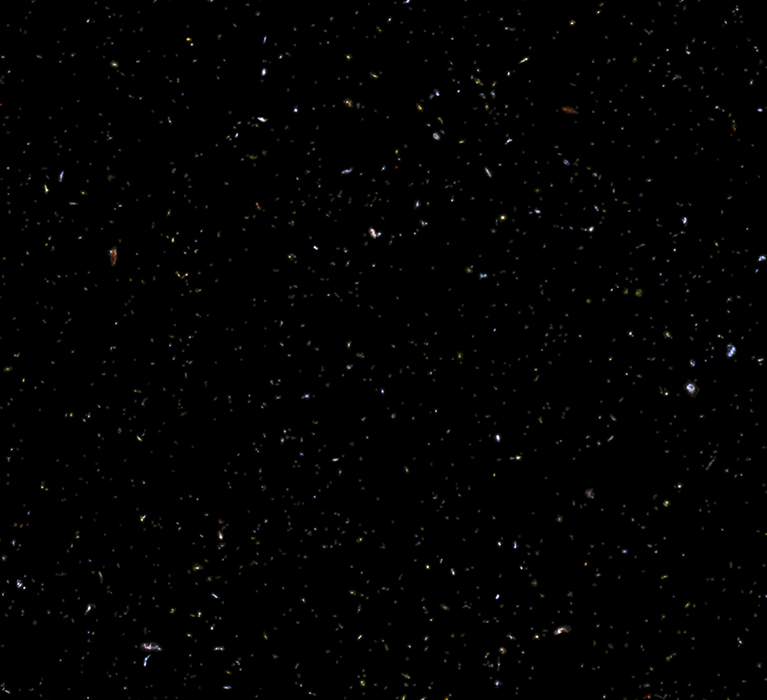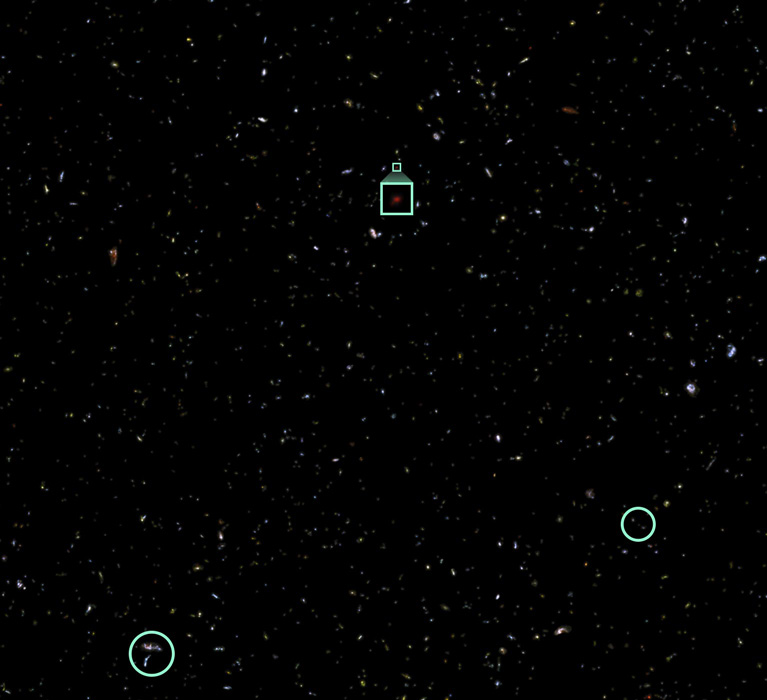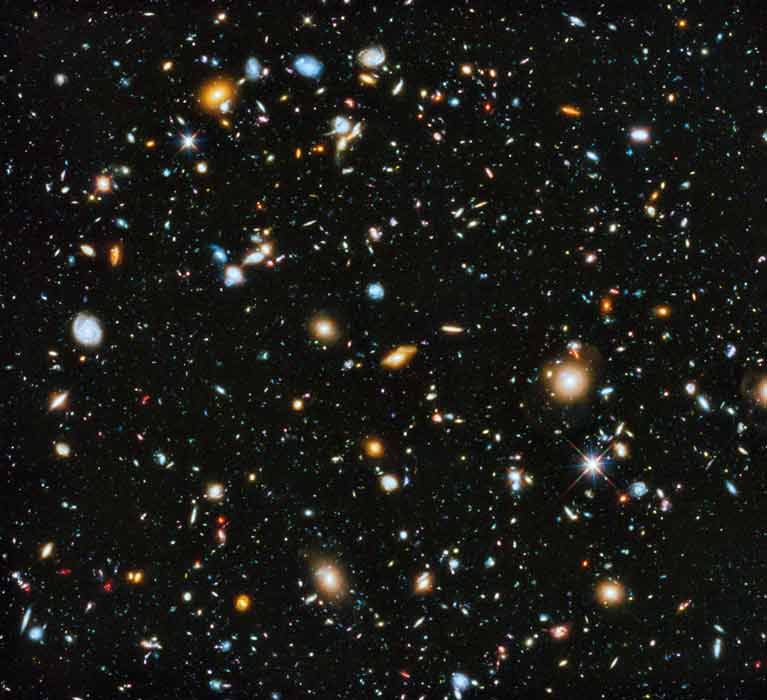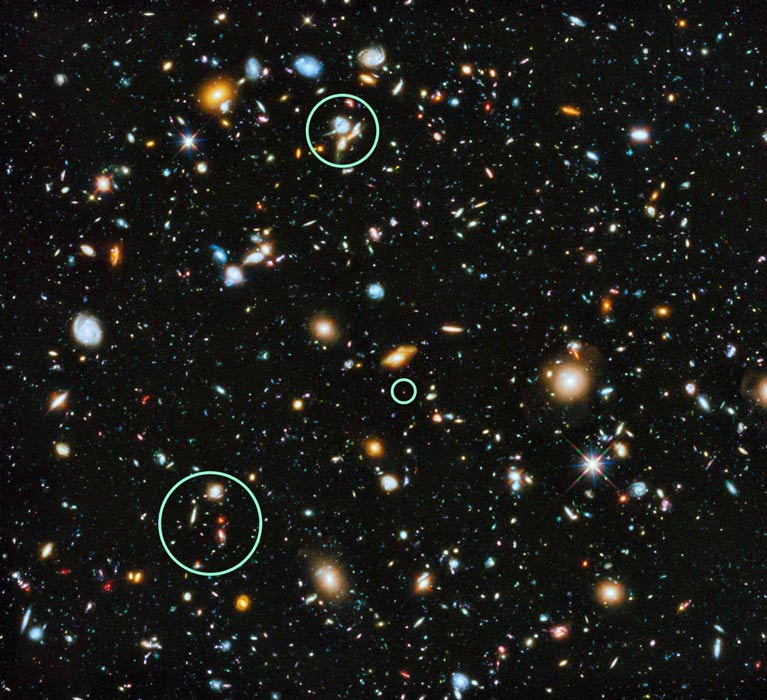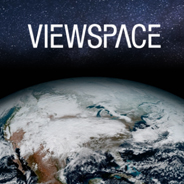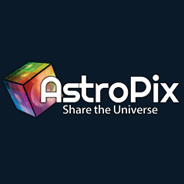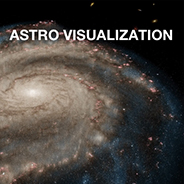Interactive Overview
Slider Interactive: A series of images showing galaxies at different distances in the same patch of sky. The images differ in terms of color and resolution, as well as the structures and detailed features that are visible. Below the caption is a horizontal slider bar with five labeled stops and a solid white circle. Dragging the white circle right and left along the slider bar causes the image, labels, and caption to change. The change occurs gradually as one image, along with its associated captions and labels, fades out and the next fades in. A toggle button to the upper right of the image turns the image labels off and on. Some labels are in the form of text with arrows pointing to specific features in the image. Other labels are graphic overlays.
Slider Stops
From left to right, the slider stops are labeled: Snapshot across time, 0-5 billion years, 5-9.6 billion years, 9.6-13.2 billion years, and Snapshot with UV & IR.
Summary of Slider Stops
Sliding left to right reveals the following:
- “Snapshot across time” stop shows a dense field of galaxies against a black swath of space. This is the initial image shown when the interactive is loaded.
- “0-5 billion years” stop shows some of the galaxies from the first stop. Most appear as small specks, with some light smudges infrequently scattered across.
- “5-9.6 billion years” stop shows a different set of galaxies from the first stop. These appear as small points of colorful light, and some larger galaxies with glowing halos.
- “9.6-13.2 billion years” stop shows a third set of galaxies from the first stop. These appear as small specks of light.
- “Snapshot with UV & IR” stop shows a dense field of bright galaxies against a black swath of space.
Stop 1: Snapshot across time
Image Description: Snapshot across time
Composite image of galaxies at all distances explored in this interactive. About 10 thousand colorful points in various sizes are scattered across the dark sky: bright orange, yellow, white, and pale blue. They range from tiny, barely discernable specks to larger spirals, hundreds of times their apparent area. Four hundred of the largest galaxies could fit in the total area of the image, though the vast majority of the visible galaxies are the tiny specks.
Labels: Snapshot across time
There are three text labels and three graphic overlays. A green circle in the top left of the image highlights a patch of various galaxies and is labeled “Color indicates distance or star formation.” A yellow-orange dot with a fuzzy halo in the center right of the image is labeled “Not all galaxies are as close as they appear.” Overlaid on the photo, in the bottom center of the image, is a large green square with a magnified view of the galaxies that are in a smaller square just above. The box is labeled “Near and distant galaxies.”
Caption: Snapshot across time
This extremely deep exposure captures a small portion of the universe across time and space, revealing a variety of galaxies.
Stop 2: 0-5 billion years
Image Description: 0-5 billion years
This image reveals the same swath of sky. A small fraction of the objects from the dense sky in the “Snapshot across time” stop is visible. Small points of light, tiny spirals, asymmetrical blobs, and thin smudge-like lines are scattered in tones of white, pale blue, and light yellow. These objects range from some of the largest appearing galaxies to some small points, but they do not include the tiniest specks.
Labels: 0-5 billion years
There are three text labels and four graphic overlays. In the upper left is a green circle that highlights a tiny galaxy with spiral arms, which looks like a small, light yellow-white blob. It is labeled “Spiral galaxy similar to ours.” Further below is a circle highlighting an asymmetrical galaxy that looks like a small white blob. It is labeled “4.6 billion light-years away.” Overlaid on the photo, in the center right of the image, is a large square with a magnified view of the small light blue points that are in a smaller square just above. It is labeled “Small, star-forming dwarf galaxies.”
Caption: 0-5 billion years
As we look out into space, we look back in time. This is a small, 5-billion-light-year “slice” of the nearby universe.
Stop 3: 5-9.6 billion years
Image Description: 5-9.6 billion years
This image reveals the same swath of sky. Objects visible in the prior “0-5 billion years” are no longer visible in this stop. A different set of objects from the “Snapshot across time” stop is visible. There are approximately three times as many objects in the “5-9.6 billion years” stop as in the prior “0-5 billion years” stop, and they tend to be a bit more orange-yellow on average. Some objects are thin smudge-like lines, others are small dots—a few with surrounding fuzzy halos—and some are spiral-shaped blobs in various colors: bright orange, yellow, white, and pale blue. Similar to the “Snapshot across time” stop, the objects seen in this stop vary greatly in size—from barely discernable specks to spirals that are hundreds of times larger in comparison.
Labels: 5-9.6 billion years
There are three text labels and one graphic overlay. A light-yellow spiral-shaped galaxy in the center left is labeled “8 billion light-years away.” In the center is a green circle with a small grouping of small points of light labeled “Blue star-forming galaxies.” A yellow-orange dot with a fuzzy halo in the center right of the image, the same object that was labeled in the “Snapshot across time” stop, is labeled “Massive elliptical galaxy.”
Caption: 5-9.6 billion years
This slice covers a larger portion of the distant universe, revealing more galaxies.
Stop 4: 9.6-13.2 billion years
Image Description: 9.6-13.2 billion years
This image reveals the same swath of sky. Objects not previously visible in the prior “5-9.6 billion years” stop are visible, and the objects that were visible in the prior two stops are no longer visible. There are about three times as many objects as in the “5-9.6 billion years” stop. The objects in this image are mostly uniform in size: small specks scattered across the dark background, though there are a few more resolved galaxies. Specks of pale blue, white, and occasionally red are scattered across, but most objects are too small to identify a color.
Labels: 9.6-13.2 billion years
There are three text labels and four graphic overlays. Overlaid on the photo, in the top center of the image, is a small square with a magnified view of a tiny red dot that is in a smaller square just above. It is labeled “Very young, distant galaxy.” In the bottom right, a green circle with two small specks of light is labeled “Tiny, distant, growing galaxies.” The green circle in the bottom left with tiny light-colored, asymmetrical galaxies is labeled “Young, distorted, interacting galaxies.”
Caption: 9.6-13.2 billion years
Now only the most distant galaxies appear, looking as they did more than 9.6 billion years ago.
Stop 5: Snapshot with UV & IR
Image Description: Snapshot with UV & IR
This image reveals the same swath of sky. It looks similar to the “Snapshot Across Time” image, but the objects appear brighter, with some of the galaxies appearing slightly larger, with additional color. Colorful points of light in various sizes are scattered across the dark sky: bright orange, yellow, white, and blue. The objects vary in size and shape. Some are thin smudge-like lines, others are small dots—a few with surrounding fuzzy halos—and other objects are spiral-shaped. A couple of the objects in this image have diffraction spikes, something that is not seen in any of the interactive’s previous stops
Labels: Snapshot with UV & IR
There are three text labels and three graphic overlays. In the top center, a green circle with a cluster of asymmetrical, colorful smudges is labeled “UV gives clues to star formation.” A small green circle in the center with a small red dot is labeled “Over 13 billion light-years away.” This dot was not visible in prior stops. The green circle in the bottom left of the image has a dense grouping of colorful objects and is labeled “More colors reveal more information.” Some of these objects have colors not visible in prior stops.
Caption: Snapshot with UV & IR
Additional ultraviolet and near-infrared images help refine distances to discover even younger, farther galaxies.
